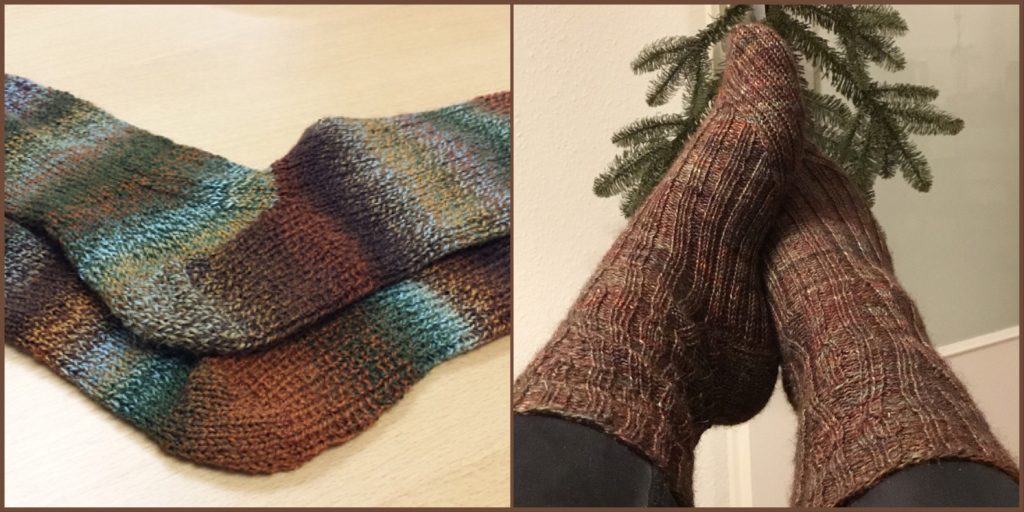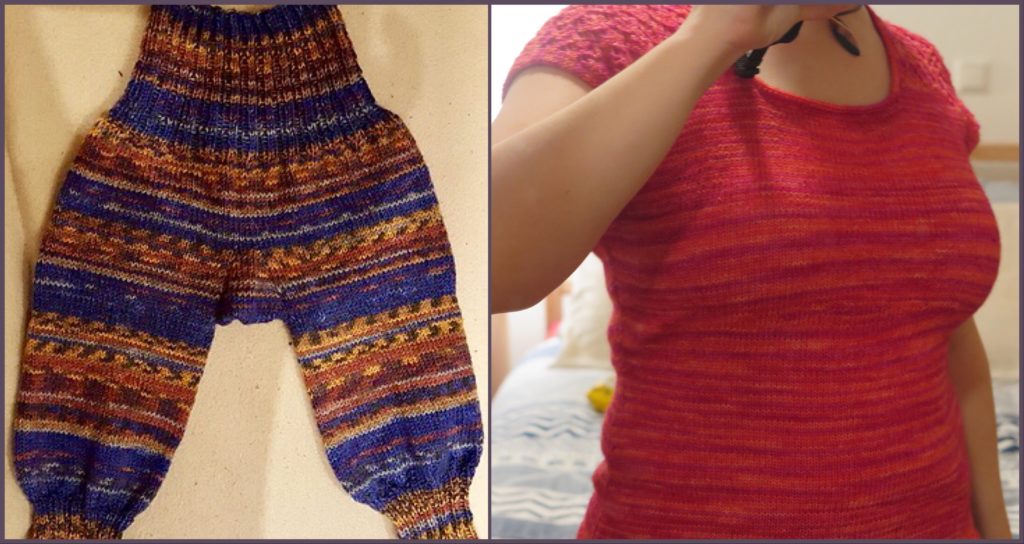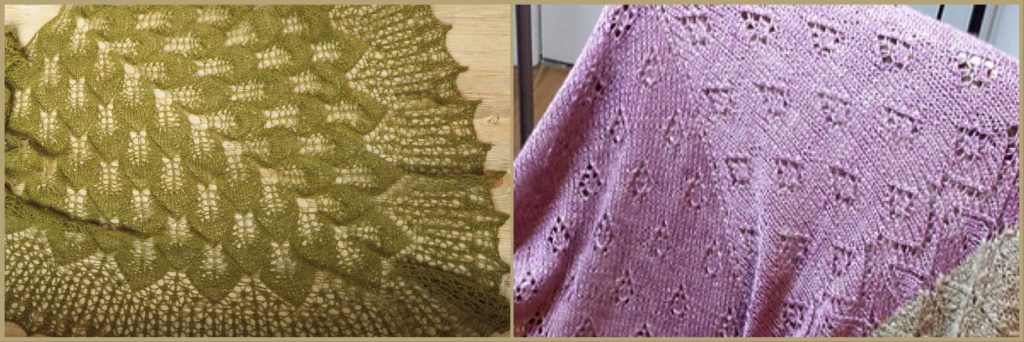Earlier this weekend somebody reached out to me via PM in Ravelry asking for help with the Frozen Leaves pattern, since I made it recently and they liked how mine turned out. They had two questions: where were the English instructions? and were the charts written out anywhere? because reading them would be hard for them. I provided some suggestions for how to read charts since the designer doesn’t have a written version of the charts. However, they had simply missed that the English instructions are on the blog post with the charts, because they are really short.
This got me thinking about what makes a pattern hard. On one hand, Frozen Leaves isn’t a difficult pattern. The lace leaf pattern is pretty easy to memorize as each row follows logically from the row below. The whole thing is symetrical as well. Only the border starts to get a bit trickier and require carefully following the chart row by row.
On the other hand, the instructions are really simple: just one little paragraph to cover a lace shawl with multiple 31 row repeats and a border. It is not detailed at all and presumes a certain ability to interpret and deduce what is captured in those instructions. In this way, the pattern is hard. It’s not what I would recommend to a knitter who likes detailed instructions, particularly if it’s their first major lace project.
So what makes a pattern hard?
Obviously, what an individual will find hard will vary person to person based on their experience, skills, appetite for problem solving and more.
But I think there are a couple different things to judge the pattern by which, matched up with an individual’s profile, we can help determine if it will be “hard” for that individual as well as where along a continuum from easy to hard it is more generally.
The first one is the one I think most people think about: what skills are needed to complete the pattern? The more skills, and the harder those skills are for a typical person to master, the harder the pattern is deemed to be. A knitting pattern only requiring casting on, knitting, purling, and binding off thus is pretty easy: these are the basic skills most knitters start with. Similarly, in crochet the starting chain, and single crochet are your basic building blocks. Once you start to add in k2tog, ssk, color stranding (dc, tr, FPdc, increases), or some combination thereof, a knitter (crocheter) will need to have invested additional time in learning knitting/crochet skills to be able to complete the pattern. Or be willing to learn them while working the pattern.

Another one is the number of stitches. People rarely measure this exactly (I’ve never seen a pattern with a total stitch count). But we eyeball it and bring it into consideration. King size blanket in lace and hat in bulky weight are at two ends of the continuum. We recognize that each stitch takes time, and more stiches means more time needed. Spending so much time on a single item is considered hard, especially if you are more on the project knitter end of the spectrum. A more skilled (here, read: faster) knitter or crocheter may take on larger projects with less trepidation because they can complete them more quickly.
Thirdly, materials. Certain fibers are harder to handle, and thin yarns may make reading work more difficult. This one can take a bit more experience to fully take into consideration. Silk may be easy to undo to correct mistakes, but by the same token, stitches run quickly when dropped, making lace a bit more risky. And how many beginners have fallen for the promise of a quick and fun scarf with novelty yarns only to realize part way through that they can’t see at all what they are doing?

These first three are pretty easy to pull into consideration before planning to buy a pattern and start a project. If there are decent pictures of the project, you can guess at the skills needed (if they aren’t already referenced in the description) and the type of object and yarn weight give a pretty decent idea of the amount of knitting/crocheting involved. So these are the things a crafter expects to make the pattern easier or harder to complete, and it’s pretty simple to match that up against your current skill set, time available, budget, etc… They are also things we expect to se the difficulty because they are core to the finished object.
It can be harder to anticipate how a couple other things will impact difficulty, because they are about the journey to getting there instead of the final item.
First, alterations, particularly for fitted clothing. Here I’m talking more about alterations which are required to make a pattern work for you, the maker, not the ones you thought would be fun to try out. When a crafter sets out to swap elements of a pattern for their own enjoyment, it’s much easier to anticipate that it may increase difficulty. I’m talking about the ones necessary for a sweater, vest or jacket, skirt or other clothing item to fit you or the recipient.
Depending on your body type and how closely it matches the standard (or the body type the designer assumed), you may find yourself making alterations, or accepting a slightly less well fitted outcome. This can increase the difficulty beyond what was expected or desired, especially for newer crafters who haven’t learned what to look out for yet. I know, for example, that my desire for a well fitted top when the top has little or negative ease, means I’ll be adding bust shaping such as short rows. This turns even relatively simple tops into something a bit more tricky for me. Of course, for those who struggle to find clothing off the rack that fits well, it can be worth the effort and extremely satisfying to learn how to alter patterns. But it doesn’t change the fact that this impacts the difficulty of the pattern.

Secondly, and completely beyond the makers control: the manner in which the pattern is written and presented impacts difficulty. How many pictures are there? How much detail is given for each step? What prior knowledge does the designer assume people have? All of these and more impact difficulty, and, much as it may be hard to accept, aside from expecting a pattern free of errors, we don’t get to decide what is the right way to write a pattern because there isn’t one.
For every person who wants a detailed pattern that covers every little step, there’s another person who is annoyed by having to wade through what feels like extra and unnecessary instructions to them. One person wants as many pictures as possible to see each step because they do everything online, so space and paper isn’t an issue, another prints everything off and doesn’t want to use up the paper and colored ink for all those pictures.
In short, a designer can’t make everybody happy and has to make choices. How much time and resources do they spend writing up the pattern? How will that impact their pricing? Who is their audience?
For an example, compare the Frozen Leaves pattern mentioned at the beginning of this post with the Ashton Shawlette:

From a knitting skills standpoint, I would consider them to be similar difficulty levels. They are designed for similar yardage, though in different weights. However, Frozen Leaves is offered for free without comment and the instructions are minimal (though sufficient as attested by the numerous people who have made it) while the Ashton Shawlette is offered explicitly as a tutorial on learning to read and use lace charts to create lace shawls. It’s extremely detailed and thorough, right down to teaching about using life lines. Let’s just say there’s a reason I did Ashton Shawlette as my first knitted lace shawl, rather than Frozen Leaves!
Another example is the ever popular Baby Surprise Jacket from Elizabeth Zimmermann. The copy I own actually has several versions of the pattern for different sizes, but also notably two versions of the baby size. One is the original pattern as written by Zimmermann, but there is also a more detailed (and authorized) version which is designed to be easier for a wider range of knitters to read and follow. I myself used this version the first time I knit the jacket, but could easily follow the more succinct original by the time I was on my fourth jacket and appreciated that these instructions fit on a single page so I never had to flip around.
So all in all, I think that when I look at how hard a pattern will be, I’m thinking about:
– Skills needed
– Amount of work (size/total stitches)
– type of materials in the yarns
– Alterations required
– Designer choices in pattern writing/presentation
